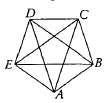Maths - Quadrilaterals
- Option : B
- Explanation : (B) From the given information, we can form the figure as,

Now, in △ABE, AB = AE (As these are the sides of regular pentagon)
So, from base angle theorem, we know
∠BEA = ∠EBA
∠BAE = 1800 (As we know each angle of regular pentagon is 1800.)
Now, from angle sum property in △ABE,
∠BEA + ∠EBA + ∠BAE = 1800,
So, ∠BEA + ∠BEA + 1800 = 1800,
2∠BEA = 720
∠BEA = 360
∠BEA = ∠EBA 360 ....... (i)
Similarly, in △DEC,
∠CED = ∠ECD 360 ....... (ii)
And in △CDB,
∠BDC = ∠DBC = 360 ....... (iii)
Then,
∠DEA = ∠BEA + ∠CEB + ∠CED
We know, ∠DEA = 1800(Angle of regular pentagon)
Then, 360 + ∠CEB + 360 = 1080
∠CEB = 360
Similarly, ∠CEB = ∠CAD
= ∠ADB = ∠ACE
= ∠DBE = 360
And sum of all 5 vertical angles of star = 360 + 360 + 360 + 360 + 360 = 1800
2. In the given figure, both ABCD and PQRS are the parallelograms. The value of θ will be

- Option : A
- Explanation : (A) From the figure, AD ∥ BC

So, ∠ADC = ∠BCR = 1200 [corresponding angles]
∴ ∠BCS = 1800 - 1200 = 600
Similarly, SP ∥ RQ
∠RQP = ∠SPB = 700 [corresponding angles]
Now, DC ∥ AP and SP is a transversal
∴ ∠RSP = 700 [alternate angles]
In △OSC,
∠OSC + ∠SCO + ∠COS = 1800
⇒ 700 + 600 + ∠COS = 1800
⇒ ∠COS = θ = 500
*/?>
*/?>
*/?>
*/?>


